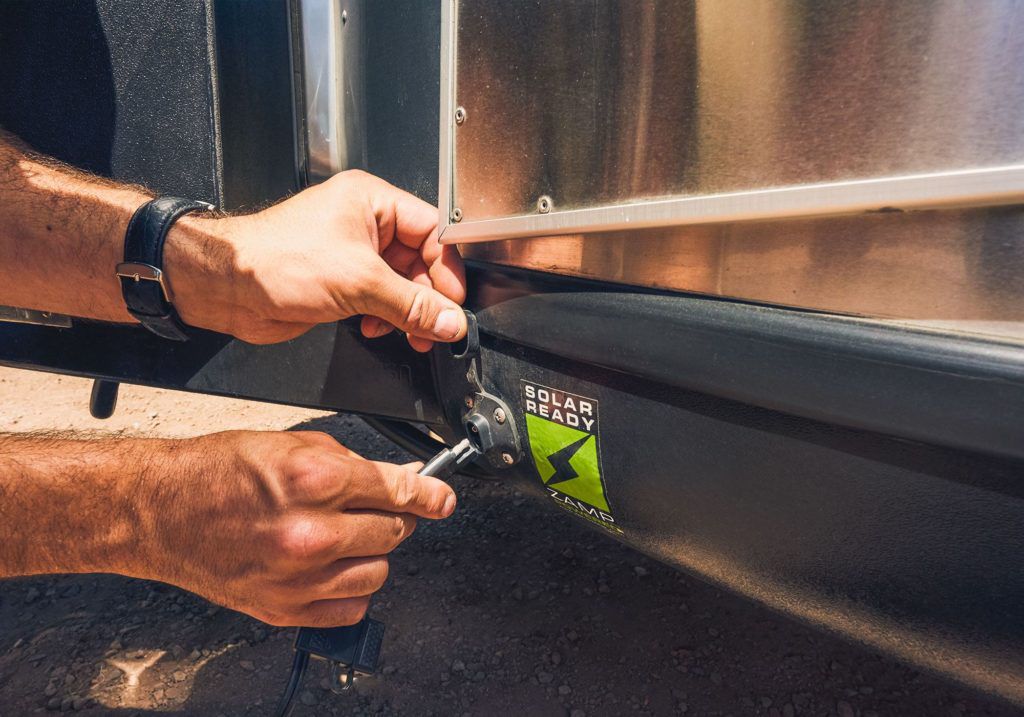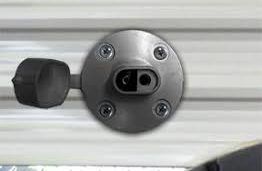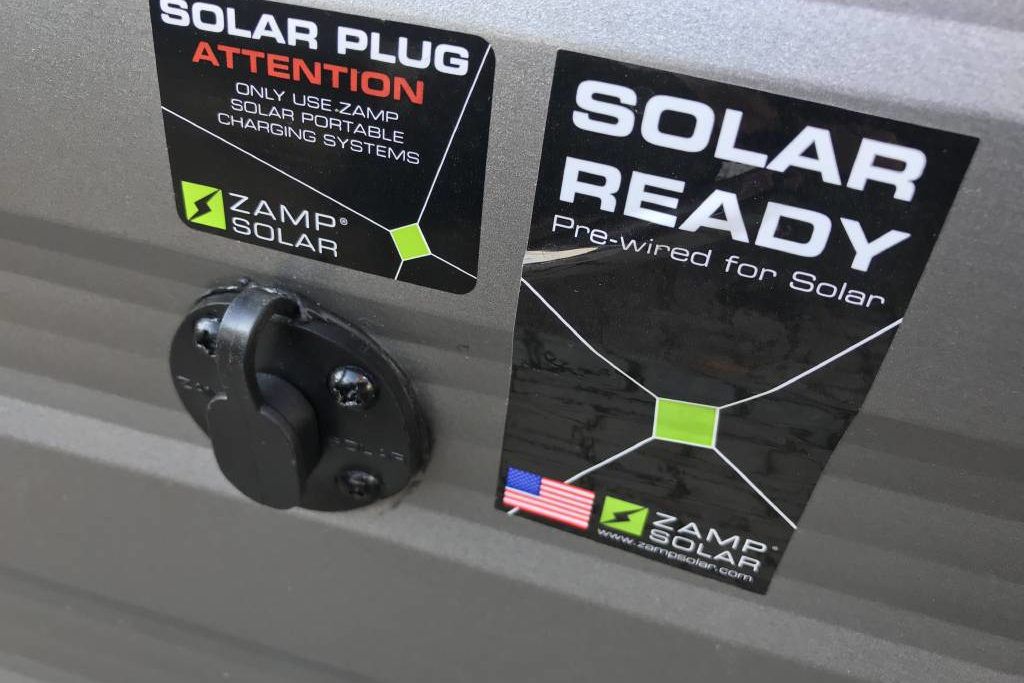

Solar power is becoming increasingly popular among RV enthusiasts, as it offers an environmentally friendly and cost-effective source of energy while on the road. If your RV is already solar-ready, you might be wondering what steps you need to take to make the most of this sustainable energy source. In this article, we will discuss the necessary components and practical considerations for harnessing solar power in your recreational vehicle.
To begin with, you’ll need to have a basic understanding of the solar power system and the essential components involved. A typical solar power setup for an RV will consist of solar panels, a charge controller, a battery bank, and an inverter. These components work together to collect, store, and convert solar energy into usable electricity for your RV’s appliances and electronics.
Some SRRV’s can harness a rooftop system or a portable system. To learn more about these types view this post: What is a Solar Ready RV?
But before you dive into buying solar for your solar ready RV, it’s time to evaluate your energy requirements. Assessing your daily power consumption will help you determine the appropriate solar panel system, battery capacity, and inverter specifications to meet your specific needs. Keep in mind that these components will vary based on factors such as your RV’s size, the number of appliances you use, and the desired duration of off-grid camping. It will also help you understand the cost associated with solar-RVing and if it makes sense for you. By understanding your usage you’ll be able to estimate your system size. Read: Solar Sizing: Three Ways to Estimate Electrical Usage for an idea on how much power you might use.
Additional SRRV Resources:
- Is RV Solar Worth It? A Friendly Guide to Weighing the Pros and Cons
- Portable Solar Panels for Your RV: Weighing the Pros and Cons


Understanding Solar Ready RVs
What is a Solar Ready RV?
A solar ready RV is a recreational vehicle that has been pre-wired for solar panels by the manufacturer. This means that the RV comes equipped with the necessary wiring and connections to support a solar power system. This feature makes it easier for RV owners to install solar panels themselves or have them professionally installed, as the essential infrastructure has already been put in place by the builders.
Popular RV Manufacturers Providing Solar Ready Options
Many RV manufacturers have recognized the growing demand for solar power and have started offering solar ready options. Here are some popular RV manufacturers providing solar ready RVs:
- Forest River: This manufacturer has a variety of RV lines that come pre-wired for solar, making it more convenient for owners to add solar panels and accessories.
- Airstream: Known for their iconic aluminum travel trailers, Airstream now offers solar ready options for some of their models, which allows for easy solar system integration.
- Jayco: Another reputable RV manufacturer, Jayco has also started offering solar ready RVs in their lineup. Their solar-ready package includes pre-installed wiring and rooftop connectors, simplifying the solar panel installation process.
Components of a Solar Power System
Solar Panels
Solar panels convert sunlight into electricity, enabling your RV to harness solar energy. Panels come in various sizes and wattages, depending on your power needs and roof space. Mounting solar panels on the roof is optimal as it ensures maximum exposure to sunlight.
More About:
- RV Rooftop Solar Systems: A Guide for Efficient and Sustainable Travel
- Portable Solar Systems: The Ultimate Portable Power Solution for Off-Grid Living
Charge Controller
A charge controller regulates the voltage and current coming from the solar panels, ensuring your batteries don’t overcharge or discharge excessively. Two types of charge controllers are commonly used: Pulse Width Modulation (PWM) and Maximum Power Point Tracking (MPPT). MPPT charge controllers are usually more efficient but also more expensive than PWM controllers.
Read up on solar controllers:
Battery Bank
The battery bank stores the electricity generated by the solar panels, allowing you to use the power when your rig is not in direct sunlight. Selecting the right size and type of battery helps make your solar RVing experience all that much better. Deep-cycle batteries, such as lead-acid or lithium-ion, are typically used for RV solar systems due to their durability and higher capacity. Sizing a battery too small can also render you without power when you need it most. Learn more about batteries with out Battery Basics Series. We go over how to size them, how to test them, how to wire them, how to care for them and more.
Inverter
An inverter converts the direct current (DC) produced by the solar panels and stored in the battery bank into alternating current (AC), which is required to power most electrical devices. Think of AC power as household power. Devices that plug in at home need AC to run. There are two types of inverters: modified sine wave and pure sine wave. A pure sine wave inverter is considered superior as it provides cleaner power, but is also more expensive than a modified sine wave inverter.
An inverter is a device that helps power your RV’s electrical system using your batteries. To connect it, you’ll need to wire it directly to your batteries and then to your RV’s electrical system. This can be tricky and requires a good understanding of AC and DC electrical.
Alternatively, some inverters come with a plug that you can just connect to your battery and plug your devices into. It’s much easier! But, if you want to power your RV’s outlets with your batteries, you’ll need to do some wiring.
If you’re not comfortable with electrical work, it’s best to call in a professional. Electricity can be dangerous, so it’s better to be safe than sorry.
Preparing Your Solar Ready RV for Solar
If you own a solar-ready RV or camper, you’re already ahead in the game for setting up an off-grid energy source. Solar-ready vehicles are usually pre-wired for solar panels, making it easier and more cost-effective to install a solar system for your mobile abode. In this section, we will discuss the necessary steps and equipment needed for preparing your solar-ready RV for harnessing solar power.
First and foremost, you should consult your RV’s manual to understand the specific configurations and details of your vehicle’s solar wiring. Manuals typically provide information on existing wiring, proprietary plug types, and other necessary components. This information will help you choose the right solar equipment to fit your RV’s pre-wired system. But also, some RV manufactures don’t do the best job at showing you the configurations. If this happens, it’s likely a good idea to consult the solar manufacture to get additional details.
Three brands of SRRV suppliers we know well are:
- Zamp Solar: The pioneers to RV solar and Solar Ready RVs
- GoPower Solar: Zamp and GoPower are now owned by Dometic. GoPower uses Solar on the Side for their SRRV setups.
- Renogy: These guys kick out a ton of solar kits and generally adapt to what’s going on in the industry with quick Chinese manufacturing.
Your solar installation will require a solar charge controller to manage electrical current between solar panels and battery banks. Most portable systems have an integrated solar charge controller, but double check. You will also need solar panels, either in the form of portable solar panels or a roof-mounted system. Portable panels, like a solar suitcase or a Renogy solar suitcase, offer flexibility, while roof-mounted panels provide a more permanent solution. Additionally, some solar-ready RVs might be equipped with a plug-and-play port, such as a Zamp or Go Power! port, which simplifies the installation process.




SIDE NOTE: When connecting your solar system to the RV, check the polarity, even manufactures make mistakes. This can be done using a voltmeter, which should indicate the positive lead (red wire) and the negative lead. If the polarity needs to be reversed, it’s as simple as reversing the wires on the battery, or getting an adapter.
An important aspect of setting up your solar system is determining the available energy you’ll need for your RV. This can be measured in amp hours (Ah) or watt hours (Wh). Your solar equipment, including the solar charge controller and panels, should be capable of providing the required amp hours to adequately power your motorhome. We’re a fan of just converting everything over to watt hours as there is a push to go from smaller voltage (12-volt panels) solar panels to larger voltage ones (24 or 48-volts). Most MPPT charge controllers to best with higher voltage and automatically convert it to charge a 12-volt battery bank.
Selecting the Right Solar Panels
When choosing solar panels for a solar-ready RV, consider the RV’s roof size and configuration. The roof space will determine the maximum size and number of panels that can be mounted. But you might not need to cover the entire surface for light use.
High-quality panels from a good manufacture will have a more extended lifespan and better efficiency. Look for panels with a reputable brand name and good customer reviews. We are not a fan of most of the flexible panels on the market. They look like a good idea but lose their efficiency in just a few years and can burn the top of your RV. If you were to look at any flexible panel we urge you to consider only CIGS technology flexible panels.
Another thing to keep in mind is the pre-wired setup of the RV. Most solar-ready rigs come with plug-and-play systems that make installing panels a breeze. Look for solar panels that can easily connect to the existing wiring of your RV, which will save time and effort during installation.




Installation and Wiring Considerations
When it comes to setting up a solar-ready RV, there are some important wiring and installation aspects to consider. First and foremost, it’s important to make sure the wiring is done correctly. Double-check that the polarity of the wiring matches the portable solar panels you will be using. Incorrect polarity can lead to a lack of power flow and can potentially damage the solar panels.
To connect the solar wiring to your RV’s pre-wire, identify the positive lead (usually red) and the negative lead (usually black). When making modifications, always connect the positive lead to the positive terminal and the negative lead to the negative terminal. Note that some solar-ready RVs may also have red and black wires pre-installed. Using a voltmeter will help to verify the correct polarity before making the connections.
Pay attention to the gauge of the wiring. Thicker wiring provides lower resistance and will be more efficient when it comes to transferring energy from the portable solar panels to your RV’s battery. The gauge of the pre-wiring installed in a solar-ready RV should be sufficient, but if it isn’t, consider upgrading the wiring before connecting your solar panels.
Portable solar panels are a user-friendly option for harnessing solar energy. They usually come with easy-to-fit mounting brackets, making it simple for anyone to install them on an RV without the need for professional assistance. Be sure to secure the panels properly when they are in use and during travel.
Lastly, it’s important to keep in mind that a solar-ready RV comes with pre-wiring, which is a great starting point for adding solar power to your rig. However, it doesn’t necessarily guarantee compatibility with all solar panels available in the market. It’s essential to research and find a solar panel setup that is a perfect match for your particular RV’s pre-wiring configuration.
Common Issues and Troubleshooting
When setting up a solar-ready RV, there can be a few common issues that may arise. In this section, we will discuss some of these problems and how to troubleshoot them.
One common issue is related to polarity. Incorrect wiring can result in reverse polarity, which means that the positive and negative wires were connected the wrong way. To check if this has occurred, use a voltmeter to measure the voltage on the terminals. If the measured voltage is negative, reverse the connections to fix the polarity. Remember that the red wire typically represents the positive connection.
Another potential problem involves modifications made to the RV’s electrical system. Some owners may have made changes to the wiring, which can cause complications for solar-ready setups. Before installing the solar panels, make sure to inspect the electrical system and fix or update any incorrect wiring.
Sometimes, the installed solar panels might not be producing power as expected. In such cases, bypassing the faulty panel(s) temporarily by using jumper cables can help restore power to the remaining panels. However, it is essential to identify the problem and permanently fix the non-functioning panel(s) to avoid lasting issues.
Dealing with issues related to wiring can also be quite common. Loose connections or damaged wires can result in the loss of power or decreased efficiency. Inspect the wiring and connections periodically to ensure they are secure and in good condition. Replace any damaged sections promptly to maintain optimal performance.
More Resources
This is a simple look at Solar Ready RVs and the solar solutions you can use. Solar is constantly changing and so are the manufactures. If your RV has a feature that we haven’t covered emails us. We’d be happy to shine some light on it. k
